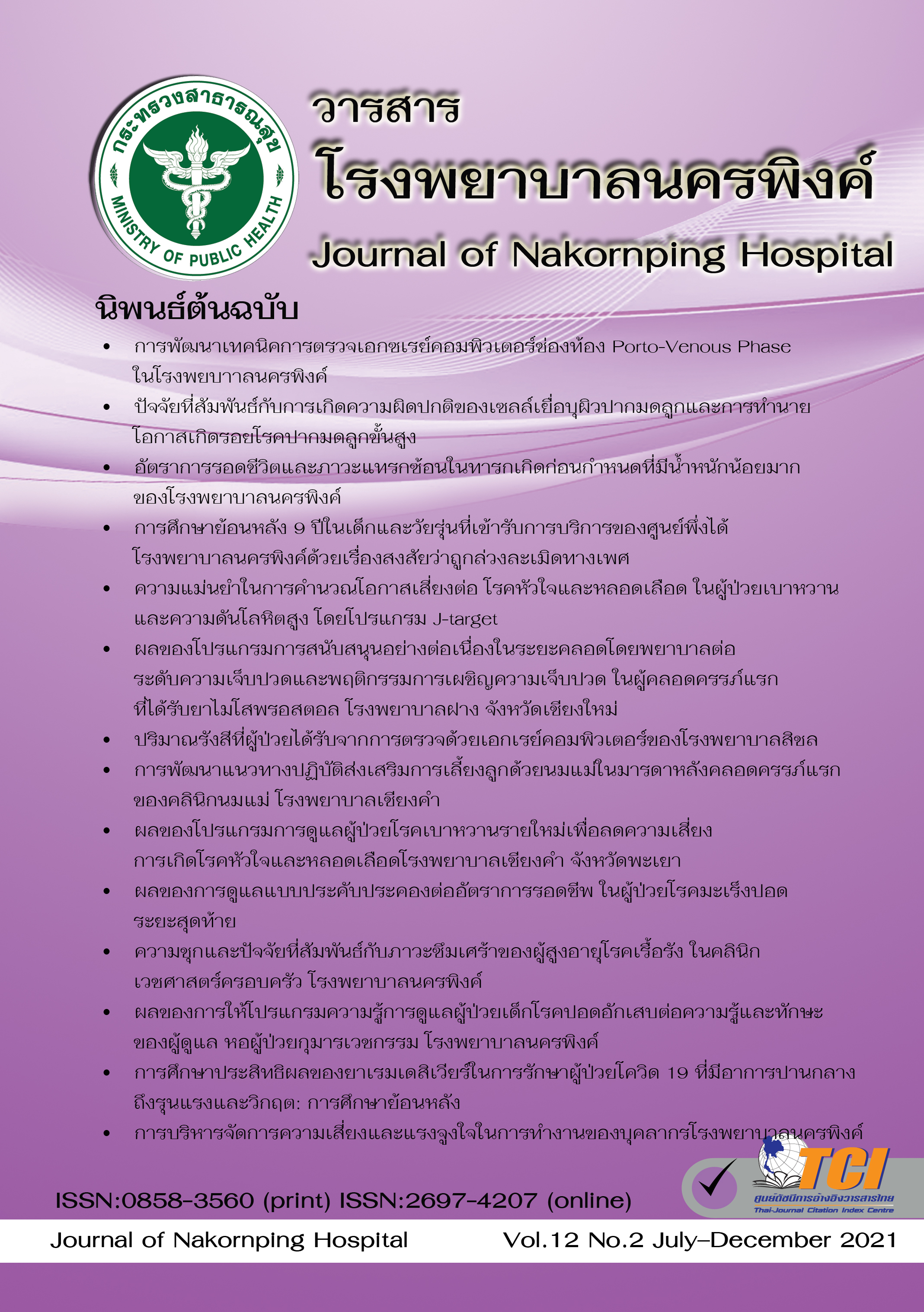The effects of palliative care towards survival rate of advanced lung cancer patients
Keywords:
lung cancer, palliative care, survival, emulation analysis, costAbstract
Objectives : To evaluate the effects of palliative care towards survival rate, numbers of day admitted in the intensive care unit, numbers of the emergency room visit, hospital costs and the defined daily dosage of analgesic use in advanced lung cancer patients.
Methods : A retrospective cohort study included advanced lung cancer patients who received palliative care program or standard care. They were hospitalized and died at Nakornping Hospital, Chiang Mai from June 1, 2016 to June 30, 2021. The follow-up time was stratified into two periods: 180 days and until death. The survival analysis was performed and presented by restricted mean survival time (RMST) and emulation analysis was used to adjust immortal bias, grace period at 90 days.
Results : The first period, 180 days follow up, contained 73 patients who received palliative care and 57 patients as a control group. The group of palliative care patients had a statistically significant lower mortality rate than the control group (Hazard ratio 0.66, 95% CI 0.46-0.96, p-value 0.023). However, the second period follow up until death contained 65 patients in each group. The weighted analysis, while eliminating immortal time bias, showed a statistically significant difference (Hazard ratio 0.48, 95% CI 0.30-0.75, p-value 0.002). Regarding original cohort group, the patients in palliative care had statistically significant higher RMST (Mean difference 12.23, 95% CI 3.28-21.18, p-value 0.008). Nonetheless, secondary outcomes showed no different between the palliative care group versus the control group throughout the treatment period until death in hospital costs for one year prior to death, numbers of day admitted in the intensive care unit, numbers of the emergency room visit and defined daily dose of morphine and fentanyl.
Conclusions : The advanced lung cancer patients who received palliative care had higher RMST than those received standard care. On the other hand, there were no differences of hospital costs for one year prior to death, numbers of day admitted in the intensive care unit, numbers of the emergency room visit and the defined daily dose of analgesic. Finally, this study provides alternative options for physicians, patients and families to plan their last golden period.
References
World Health Organization. Cancer today Data visualization tools for exploring the global cancer burden in 2020 [Internet]. Switzerland: World Health Organization; 2021 [cited 2021 Oct 16]. Available from: https://gco.iarc.fr/today/home/
Office of the Permanent Secretary Ministry of Public Health, Strategy and Planning Division. Public health statistics 2019 [Internet]. Nonthaburi: Strategy and Planning Division; 2019 [cited 2021 Oct 10]. Available from: https://bps.moph.go.th/new_bps/sites/default/files/statistic62.pdf
Panchaipetch T. Lung cancer [Internet]. Bangkok: Siriraj Cancer Registry; n.d. [cited 2021 Oct 17]. Available from: https://www.si.mahidol.ac.th/th/department/cancer/knowledgedetail.php?sub=lung (In Thai)
Chula cancer. Staging of cancer [Internet]. Bangkok: King Chulalongkorn Memorial Hospital; 2021 [cited 2021 Oct 1]. Available from: https://www.chulacancer.net/faq-list-page.php?id=328 (In Thai)
Srisam-Ang K, Podhipak A, Narksawat K, Supaattagorn P, Tipayamongkholgul M. Survival of patients with advanced non-small-cell lung cancer at Ubon Ratchathani Cancer Center, Thailand. Southeast Asian J Trop Med Public Health. 2005;36(4):994-1006.
Cancer research UK. Cancer survival statistics [Internet]. London: Cancer research UK; 2021 [cited 2021 Oct 16]. Available from: https://www.cancerresearchuk.org/health-professional/cancer-statistics/survival#heading-Four
Hui D, Bruera E. Integrating palliative care into the trajectory of cancer care. Nat Rev Clin Oncol. 2016;13(3):159–71.
Ambroggi M, Biasini C, Toscani I, Orlandi E, Berte R, Mazzari M, et al. Can early palliative care with anticancer treatment improve overall survival and patient-related outcomes in advanced lung cancer patients? A review of the literature. Support Care Cancer. 2018;26(9):2945–53.
Buranupakorn T, Thangsuk P, Patumanond J, Phinyo P. Emulation of a Target Trial to Evaluate the Causal Effect of Palliative Care Consultation on the Survival Time of Patients with Hepatocellular Carcinoma. Cancers. 2021;13(5):992.
Maringe C, Benitez MS, Exarchakou A, Smith M, Rachet B, Belot A, et al. Reflection on modern methods: trial emulation in the presence of immortal-time bias. Assessing the benefit of major surgery for elderly lung cancer patients using observational data. Int J Epidemiol. 2020;49(5):1719-29. doi: 10.1093/ije/dyaa057.
Vanbutsele G, Pardon K, Van Belle S, Surmont V, De Laat M, Colman R, et al. Effect of early and systematic integration of palliative care in patients with advanced cancer: a randomised controlled trial. Lancet Oncol. 2018;19(3):394-404.
Yosick L, Crook RE, Gatto M, Maxwell TL, Duncan I, Ahmed T, et al. Effects of a Population Health Community-Based Palliative Care Program on Cost and Utilization. J Palliat Med. 2019;22(9):1075–81.
Smith S, Brick A, O'Hara S, Normand C. Evidence on the cost and cost-effectiveness of palliative care: a literature review. Palliat Med. 2014;28(2):130-50. doi: 10.1177/0269216313493466.
Downloads
Published
How to Cite
Issue
Section
License
The articles that had been published in the journal is copyright of Journal of Nakornping hospital, Chiang Mai.
Contents and comments in the articles in Journal of Nakornping hospital are at owner’s responsibilities that editor team may not totally agree with.



